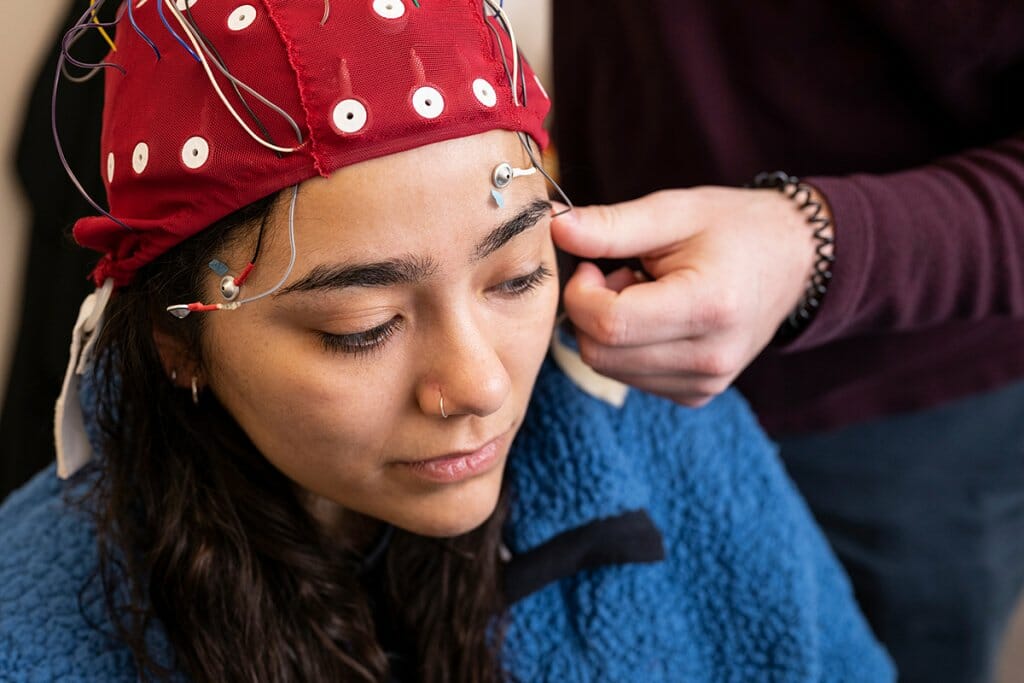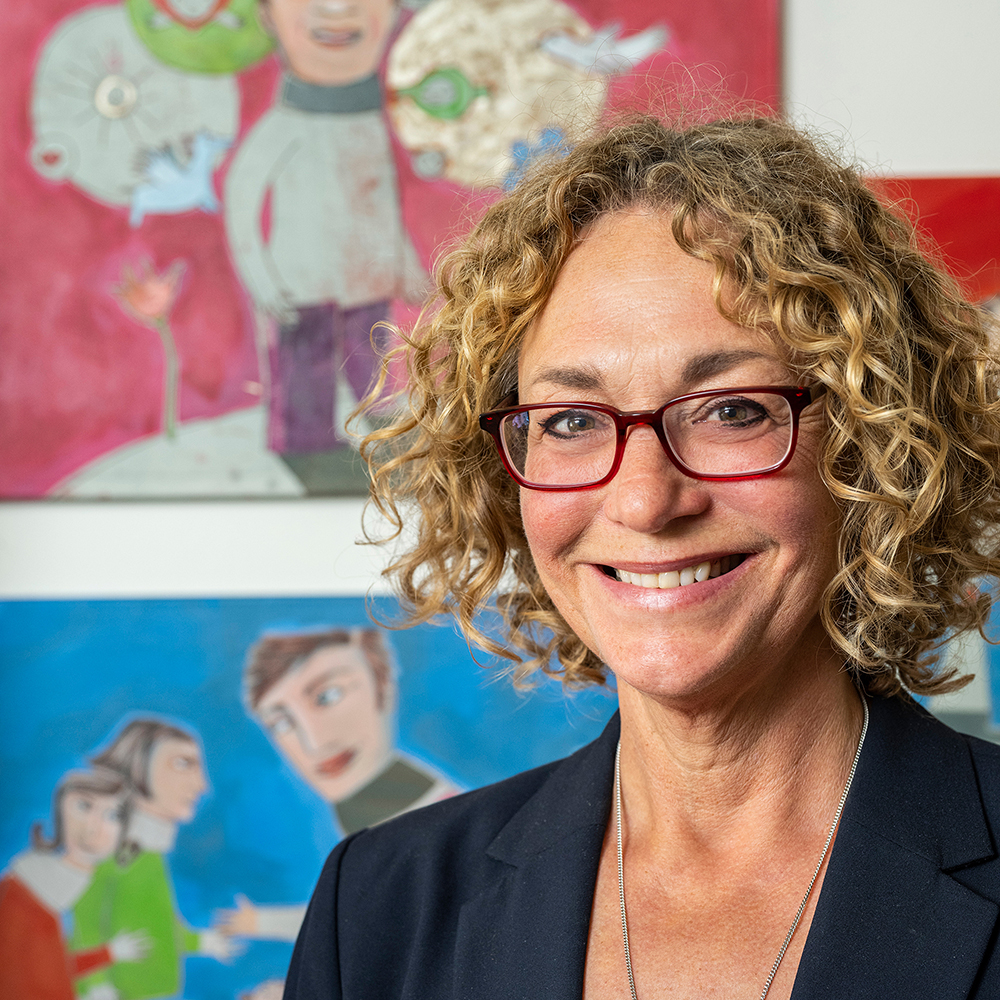
The Science behind a Smile
UW psychology professor Paula Niedenthal ’81 explores the wide variety of social rules for expressing emotion — and how they cause trouble.
A stranger smiles at you on the street. If you were raised in the United States, you’ll probably assume this person is happy, friendly, or proud of their dental work. If you grew up in Norway or Russia, you’re likely to draw different conclusions. Americans are often stereotyped as loud, constantly smiling dimwits, a fact that shapes perceptions of smiling strangers abroad. The Norwegian government jokes that a stranger who smiles at you may be viewed as “drunk, insane, American, or all [three]” in a pamphlet titled Living and Working in Norway. Meanwhile, smiling at a stranger is viewed as insincere — or worse, idiotic — in Russia and quite a few other nations.
UW–Madison psychology professor Paula Niedenthal ’81 recalls a conversation with a Russian journalist who had called to discuss her research. He remarked that wide, expressive American smiles are fake, unlike the smiles of other cultures.
This was during the 14-year stretch when she lived in France, working for the National Centre for Scientific Research and the University of Clermont-Ferrand. Comments of this nature were common during her time abroad, and they never ceased to rankle her.
“It became clear that many people believe American smiles are inauthentic and manipulative, as well as deeply embedded in capitalism,” Niedenthal says.
How did these assumptions develop? Why are they so prevalent? What might help change them? She set out to answer these questions in 2011, when she joined UW–Madison’s faculty and founded the Niedenthal Emotions Lab. She and a team of graduate students and postdoctoral researchers study the relationship between migration patterns and societal rules about expressing emotion. These unstated rules are key components of something known as emotion culture.
In addition to promoting understanding and a sense of what to expect from others, a shared emotion culture can help people from different ethnic, religious, or linguistic backgrounds find common ground. But there’s also a dark side. Outsiders may misinterpret another group’s emotion culture, breeding stereotypes, confusion, and cross-cultural conflict.
This is how a smile’s good intentions get lost in translation.
Smiling to Survive
“I don’t think some people are more emotionally expressive than others because they’re stupid or manipulative,” Niedenthal says. “There’s something else going on.”
Niedenthal’s research suggests that this special something involves the history of cross-cultural interactions in a particular place. How these interactions happened, how often they happened, and how long ago they began all matter.
In regions where people from different cultural, ethnic, and linguistic backgrounds have had to communicate and adapt generation after generation, a preference for big, clear expressions of emotion tends to develop. The process can take hundreds of years.
Niedenthal and her team have found that this attribute — historical heterogeneity — predicts how often people smile across different countries and U.S. states. They’ve also found that people from places with a long history of cross-cultural contact use smiles that signal friendliness more often than people from places where most of the population relies on the same language and customs.
Examples of this phenomenon abound in the upper Midwest, including Wisconsin, which received immigrants from a wide range of cultures in the 1800s. The influx of immigrants led to numerous cross-cultural interactions, especially in the context of farming. Trade and collaboration were vital. If the farmhand you hired didn’t speak your language, or if you needed help extinguishing a barn fire, you had to find a way to communicate your needs.
“Being more expressive with your face can help establish trust when language isn’t doing the job,” Niedenthal says. “If I know you want wheat to be unloaded at the grain elevator, but I don’t know your language well, I’m going to smile at you to show that I’m cooperative, and that I’m not a threat to you or your lifestyle.”

Ivette Colón PhDx’25 demonstrates a facial recognition study conducted by the Niedenthal Emotions Lab.
In situations like these, smiling isn’t about joy. It’s about survival.
This framework for understanding emotion culture explains why a person in present-day Norway typically wouldn’t smile at a stranger, but a Norwegian who emigrated to Wisconsin in the 1850s would have smiled at his new neighbors from Germany, Ireland, and Poland. It also explains why the immigrant’s great-great-grandchildren probably smile at strangers on American streets. Heightened emotional expressiveness became a part of Wisconsin’s regional culture because its value persisted as immigration continued, and because it began to feel familiar.
Back in Norway, people rarely needed to communicate across cultural or linguistic divides. As a result, they didn’t need to adopt big, clear facial expressions — and the thought of doing so still feels weird today.
"Being more expressive with your face can help establish trust when language isn't doing the job."
Challenging Assumptions
Many people — especially motivational speakers and curators of inspirational Pinterest boards — would be shocked to learn that smiling isn’t a universal language or an unmistakable sign of happiness.
First of all, smiling isn’t always about joy, as much as we might want it to be. Second, assuming that all smiles are happy ones can lead to logical errors. If genuine smiles are assumed to reflect joy and someone smiles a great deal, this person would appear to be in a state of constant bliss. This just isn’t possible, even for the most devoted optimist.
Instead of concluding that the person is delusional or dishonest, we need to examine our assumptions, Niedenthal argues.
“Smiles can show a range of emotions and intentions,” she says. “You might smile because you feel superior to someone else, which is what we call a dominant smile, or you might smile to show approval, which is a type of reward smile. These two smiles look different from each other, and neither one is inauthentic.”
On the flip side, a culture that frowns upon grins isn’t necessarily dour. It’s most likely operating with a different set of rules. Learning about these rules and appreciating why they emerged can help correct misguided assumptions, Niedenthal explains.
“My lab’s research doesn’t show that a particular culture is smarter or better than another one,” she says. “It’s more helpful to think of culture as a solution to the pressures people face in their environment. Understanding that these pressures result in different cultural practices can be humbling, and that humility can help us be far less judgmental.”
Culture, in other words, is a product of adaptation. We must adapt when we enter a new environment or when our current environment changes. Certain kinds of change come easier to some of us because our culture has trained us to endure the discomfort. One of the newest findings from Niedenthal’s lab suggests why this might be.
People from places with a long history of cross-cultural contact use smiles that signal friendliness more often than people from places where most of the population relies on the same language and customs.
Stress-Fighting Superpowers
Expressive displays of emotion can be exhausting to produce — and to observe. Big smiles and sustained eye contact use substantial amounts of energy, and these behaviors put us in a state of emotional arousal. The discomfort that arises when we’re surrounded by people we consider different also produces this state. And now there’s evidence that regions with a long history of cross-cultural contact confer a superpower of sorts: conserving energy by keeping this type of stress in check.
Niedenthal suspected that people from such places would be better equipped to handle emotional arousal. To test this hypothesis, her team looked at vagal tone, a measure of pulse-rate variability associated with breathing. People with high vagal tone can relax faster than people with low vagal tone after a stressful event.
As predicted, the researchers found that people from Wisconsin and other ancestrally diverse U.S. states had the highest levels of vagal tone. This suggests that the residents of ancestrally diverse places are likely to find big smiles more appealing — or at least less exhausting — than residents of places where cross-cultural contact has been minimal. Plus, they’re less likely to feel overwhelmed in the presence of cultural diversity.
But how did people develop this type of post-stress resilience in the first place? Once again, Niedenthal points to adaptation.
“If you grew up in an ancestrally diverse place, you’d have to confront differences without attacking other people and interpret facial expressions without becoming too emotionally aroused,” she says.
Learning to regulate that emotional response would help you adapt to the demands of frequent cross-cultural contact. Over time, as that skill was practiced again and again, it could evolve into an automatic response.
These conclusions aren’t just fascinating to think about. They’re making a mark on the real world. People who teach others how to regulate their emotions — a list that includes psychologists, occupational therapists, and kindergarten teachers — can find all sorts of practical applications for Niedenthal’s research. So can immigration lawyers, English as a second language instructors, and other professionals who serve a diverse set of clients.
Bridging Cultural Divides
Many psychotherapists are eager to tailor their craft to the needs of clients who don’t share their cultural background. Understanding a client’s native emotion culture and applying its rules appropriately can bring a valuable new dimension to psychotherapy while strengthening trust and motivation.
May Han, a marriage and family therapist who offers cross-cultural counseling for children of immigrants and transracial adoptees, says all mental health clinicians can benefit from learning about cultural differences in emotional expressiveness.
“This gives clinicians a general idea of the rules for displaying emotions so they can meet clients where they are at and help them facilitate a better relationship with their emotions,” she says.
Han says research like Niedenthal’s matters because it acknowledges how big emotions can live inside anyone, including people from cultures that prefer stone-faced stares to smiles.
“Just because someone seems to have less intense emotions on the outside, it doesn’t mean they’re not experiencing something deep inside,” she says.
Niedenthal agrees that it’s crucial to acknowledge what may lie beneath the surface. This is especially important in international commerce and foreign affairs, where faulty assumptions can derail business deals, peace treaties, and more. Facial expressions form a wordless language that requires skillful interpretation. Gaining this skill takes time and practice, and a conscious effort to withhold judgment.
“The type of [cross-cultural] training that’s popular in the business world often relies on value-laden clichés that are wrong and have damaging effects,” Niedenthal says. “Removing those value judgments can help us establish common ground in a way that doesn’t seem superficial or fake to someone from another culture. It helps us build mutual trust and respect — and ultimately, strong relationships.” •
Jessica Steinhoff ’01 has been known to smile at strangers on State Street.
Published in the Summer 2022 issue





Comments
NR June 6, 2023
In my opinion, people in Wisconsin alienate people from other cultures with their wide smiles. I am saying this as someone from another culture that when someone from Wisconsin smiles at me like that, I tend to feel depressed and discriminated against. It feels like this person is trying to force me to smile back when I am not in the mood and definitely doesn’t make me feel welcome but makes me feel more alienated from the culture
Marco March 9, 2025
Reply to NR: As the article indicates, you need “to confront differences without attacking other people and interpret facial expressions without becoming too emotionally aroused.” If you don’t do this, you are going to find life in Wisconsin (any many other parts of the United States) stressful. It is just the nature of the emotional culture.